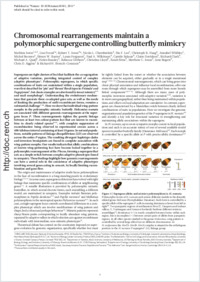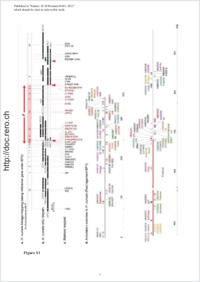Chromosomal rearrangements maintain a polymorphic supergene controlling butterfly mimicry
- Joron, Mathieu CNRS UMR 7205, Museum National d'Histoire Naturelle, Paris, France - Institute of Evolutionary Biology, University of Edinburgh, Ashworth Laboratories, Edinburgh, UK - Institute of Biology, Leiden University, Leiden, The Netherlands
- Frezal, Lise CNRS UMR 7205, Museum National d'Histoire Naturelle, Paris, France
- Jones, Robert T. Centre for Ecology and Conservation, School of Biosciences, University of Exeter, Cornwall Campus, Penryn, UK
- Chamberlain, Nicola L. Centre for Ecology and Conservation, School of Biosciences, University of Exeter, Cornwall Campus, Penryn, UK
- Lee, Siu F. Department of Genetics, Bio21 Institute, University of Melbourne, Victoria, Australia
- Haag, Christoph R. Department of Biology, Ecology and Evolution, University of Fribourg, Switzerland
- Whibley, Annabel CNRS UMR 7205, Museum National d'Histoire Naturelle, Paris, France
- Becuwe, Michel Institute of Evolutionary Biology, University of Edinburgh, Ashworth Laboratories, Edinburgh, UK
- Baxter, Simon W. Department of Zoology, University of Cambridge, UK
- Ferguson, Laura Department of Zoology, University of Cambridge, UK
- Wilkinson, Paul A. Centre for Ecology and Conservation, School of Biosciences, University of Exeter, Cornwall Campus, Penryn, UK
- Salazar, Camilo Smithsonian Tropical Research Institute, NAOS island, Causeway Amador, Panama, Republica de Panama
- Davidson, Claire The Wellcome Trust Sanger Institute, Cambridge, UK
- Clark, Richard The Wellcome Trust Sanger Institute, Cambridge, UK
- Quail, Michael A. The Wellcome Trust Sanger Institute, Cambridge, UK
- Beasley, Helen The Wellcome Trust Sanger Institute, Cambridge, UK
- Glithero, Rebecca The Wellcome Trust Sanger Institute, Cambridge, UK
- Lloyd, Christine The Wellcome Trust Sanger Institute, Cambridge, UK
- Sims, Sarah The Wellcome Trust Sanger Institute, Cambridge, UK
- Jones, Matthew C. The Wellcome Trust Sanger Institute, Cambridge, UK
- Rogers, Jane The Wellcome Trust Sanger Institute, Cambridge, UK
- Jiggins, Chris D. Department of Zoology, University of Cambridge, UK
- ffrench-Constant, Richard H. Centre for Ecology and Conservation, School of Biosciences, University of Exeter, Cornwall Campus, Penryn, UK
-
14.08.2011
Published in:
- Nature. - 2011, vol. 477, no. 7363, p. 203-206
English
Supergenes are tight clusters of loci that facilitate the co-segregation of adaptive variation, providing integrated control of complex adaptive phenotypes1. Polymorphic supergenes, in which specific combinations of traits are maintained within a single population, were first described for ‘pin’ and ‘thrum’ floral types in Primula1 and Fagopyrum2, but classic examples are also found in insect mimicry3, 4, 5 and snail morphology6. Understanding the evolutionary mechanisms that generate these co-adapted gene sets, as well as the mode of limiting the production of unfit recombinant forms, remains a substantial challenge7, 8, 9, 10. Here we show that individual wing-pattern morphs in the polymorphic mimetic butterfly Heliconius numata are associated with different genomic rearrangements at the supergene locus P. These rearrangements tighten the genetic linkage between at least two colour-pattern loci that are known to recombine in closely related species9, 10, 11, with complete suppression of recombination being observed in experimental crosses across a 400-kilobase interval containing at least 18 genes. In natural populations, notable patterns of linkage disequilibrium (LD) are observed across the entire P region. The resulting divergent haplotype clades and inversion breakpoints are found in complete association with wing-pattern morphs. Our results indicate that allelic combinations at known wing-patterning loci have become locked together in a polymorphic rearrangement at the P locus, forming a supergene that acts as a simple switch between complex adaptive phenotypes found in sympatry. These findings highlight how genomic rearrangements can have a central role in the coexistence of adaptive phenotypes involving several genes acting in concert, by locally limiting recombination and gene flow.
- Faculty
- Faculté des sciences et de médecine
- Department
- Département de Biologie
- Language
-
- English
- Classification
- Biological sciences
- License
- License undefined
- Identifiers
-
- RERO DOC 24831
- DOI 10.1038/nature10341
- Persistent URL
- https://folia.unifr.ch/unifr/documents/302070
Other files
Statistics
Document views: 104
File downloads:
- haa_crm.pdf: 196
- haa_crm_sm.pdf: 83

